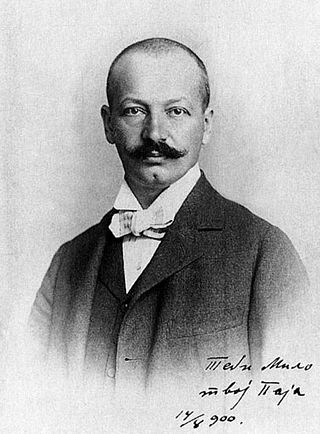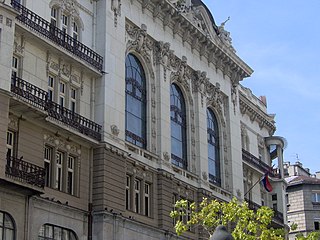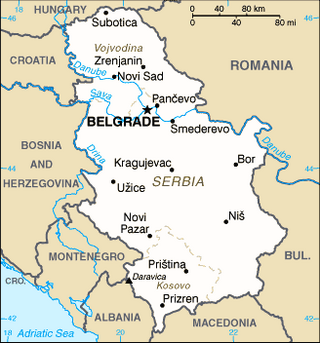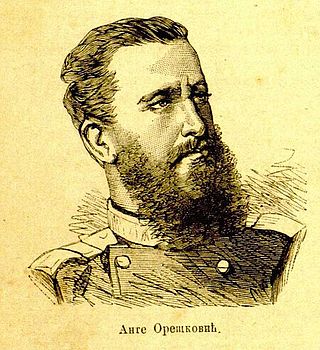Related Research Articles

Mihailo Obrenović was the ruling Prince of Serbia from 1839 to 1842 and again from 1860 to 1868.

Vračar is an affluent urban area and municipality of the city of Belgrade known as the location of many embassies and museums. According to the 2022 census results, the municipality has a population of 55,406 inhabitants.

Senjak is an urban neighborhood of Belgrade, the capital city of Serbia. Located in Savski Venac, one of the three municipalities that constitute the very center of the city, it is an affluent neighborhood containing embassies, diplomatic residences, and mansions. Senjak is generally considered one of the wealthiest parts of Belgrade.
Englezovac is an urban neighborhood of Belgrade, the capital of Serbia. It is located in the Belgrade's municipality of Vračar.

Pavle "Paja" Jovanović was a Serbian realist painter who painted more than 1,100 works including: The Wounded Montenegrin (1882), Decorating of the Bride (1886), The Takovo Uprising (1894), Migration of the Serbs (1896) and The Proclamation of Dušan's Law Codex (1900). As one of the best European painters of oriental scenes, Paja at the end of the 19th century turned to painting historical events of Serbian history. Paja was also the premier portraitist of Europe after 1905. He painted the Emperor Franz Joseph I of Austria 15 times, he painted royalty, major industrialists, scientists, bankers, oil barons and monopolists, including certain heirs to the Standard Oil fortune in the United States. He was a very sought-after portraitist world-wide, which made him incredibly wealthy in his lifetime. Many European and international museums carry his works, signed under various names including: Paul Joanowitch in the National Gallery of Victoria and also two portraits in the Utah Museum of Fine Arts, Paul Joanowits, Paul Ivanovitch, Paul Joanovitch, Paul Joanovitsch, P. Joanowitsch and others.

Uroš Predić was a Serbian Realist painter. Along with Paja Jovanović and Đorđe Krstić, he is considered the most important Serbian painter of realism. Predić is best remembered for his early works, in which he depicted the "real" life of ordinary people. Later, he made a great contribution in church painting and portraits. Predić's opus includes a total of 1658 works.

Skadarlija is a vintage street, an urban neighborhood and former municipality of Belgrade, Serbia, located in the Belgrade municipality of Stari Grad. Skadarlija partially preserves the ambience of traditional urban architecture, including archaic urban organization, and is known as the main bohemian quarter of Belgrade, similar to Montmartre in Paris. Since 1967, Skadarlija has been protected by law as a spatial cultural-historical unit.

The Serbian Academy of Sciences and Arts is a national academy and the most prominent academic institution in Serbia, founded in 1841 as Society of Serbian Letters.
Jatagan Mala is a former urban neighborhood of Belgrade, the capital of Serbia. It existed from 1919 to 1961 and was located in the municipality of Savski Venac. Jatagan Mala became a point of media interest in 2017 with the broadcast of TV serial Shadows over Balkan, which was partially located in Jatagan Mala during the Interbellum.
Lion is an urban neighborhood of Belgrade, the capital of Serbia. It is located in Belgrade's municipality of Zvezdara.

The New Cemetery is a cemetery complex in Belgrade, Serbia, with a distinct history. It is located in Ruzveltova street in Zvezdara municipality. The cemetery was built in 1886 as the third Christian cemetery in Belgrade and as the first architecturally and urbanistically planned cemetery in Serbia.

The Serbian Revolutionary Organization or Serbian Chetnik Organization was a paramilitary revolutionary organization with the aim of liberation of Old Serbia from the Ottoman Empire. Its Central Committee was established in 1902, while the Serbian Committee was established in September 1903 in Belgrade, by the combined Central Boards of Belgrade, Vranje, Skopje and Bitola. Its armed wing was activated in 1904. Among the architects were members of the Saint Sava society, Army Staff and Ministry of Foreign Affairs. It operated during the Struggle for Macedonia, a series of social, political, cultural and military conflicts in the region of Macedonia; its operations are known as Serb Action in Macedonia.
Kosta Hristić was a Serbian lawyer, diplomat and Minister of Justice.

Tourism in Serbia is officially recognized as a primary area for economic and social growth. The hotel and catering sector accounted for approximately 2.2% of GDP in 2015. Tourism in Serbia employs some 120 000 people, about 4.5% of the country's workforce. In recent years the number of tourists is increasing. In 2019, tourism generated an income of nearly $1.698 billion, hosting 1.85 million tourists. Chinese tourists were the most numerous visitors, followed by tourists from Bosnia and Herzegovina, Bulgaria, Turkey, and Germany. In 2022, tourism earnings surged to $2.71 billion and almost 2 million tourists visited the country. Major destinations for foreign tourists are Belgrade, Novi Sad and Niš, while domestic tourists prefer spas and mountain resorts. Eco-friendly and sustainable tourism has also become very popular among domestic tourists, with many visiting various nature reserves and parks in the western and southern part of the country. Serbia is also known for gastronomic tourism, with Belgrade being the central meeting point with over 2000 restaurants, coffee shops, bars and nightlife venues.

The Belgrade printing house was a printing house established by count Radiša Dmitrović in Belgrade, Ottoman Serbia. It was the first printing house in Belgrade. After Dmitrović's death, the printing house was taken over by Trojan Gundulić, who organized publishing of the first and only book of this printing house, the Gospel, printed and edited in 1552 by Hieromonk Mardarije.

Vasilije Vasa Simić was a Serbian lawyer, judge and attorney. He studied law in Paris and Geneva. He was president of the Belgrade Town Court and royal prosecutor in the summary court in the proceedings following the "Ivandan assassination attempt" on King Milan in 1899. After the fall of the Obrenović dynasty in 1903, he was retired early from the position of judge of the Appellate Court in Belgrade and started his career as an attorney at law. During both of the Balkan Wars in 1912 and 1913 and World War I, 1914–1918, he was a reserve captain in the Supreme Command of the Serbian army and retreated with the army across Albania to the island of Corfu in 1916. He took part in the Battle of Kaymakchalan and the breach of the Salonika front. He was an expert at the Paris Peace Conference in 1919. He died in Belgrade at the age of 65.
Obilićev Venac, a pedestrian and shopping zone, is located in the city center of Belgrade, Serbia, within the Knez Mihailova Street spatial unit protected by law, and contains a number of residential and office buildings dating from 1900 to 2000.

Vozarev Cross is located in Belgrade, in the park between Vojvode Šupljikca Street and Mileševska Street, and it was erected in 1847. It represents the immovable cultural property as the cultural monument. The famous Belgrade bookseller and a printer, Gligorije Vozarević, erected a wooden cross decorated with icons in his own field at Vračar. The contemporaries interpreted the erection of the cross not only as the symbol of the faith and religion, but also as the symbol of the liberation – the symbol of the victory. For that reason, this cross is considered as the first public monument in Belgrade. The ruined wooden cross was replaced by the Belgrade Municipality in 1933 with one in red artificial stone. The part of Belgrade was named after it Crveni Krst.

Colonel Antonije "Ante" V. Orešković was a Serbian colonel and a Serb of Military Frontier origin.
Dragan S. Jovanović is a Serbian engineer, administrator, and politician. He served in the National Assembly of Serbia from 2004 to 2007 and was at different times the director of the TPP Nikola Tesla and TPP Kostolac energy plants. Jovanović is a member of the Socialist Party of Serbia.